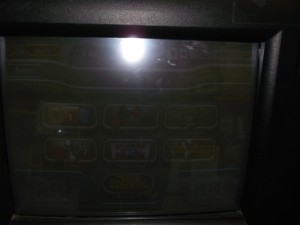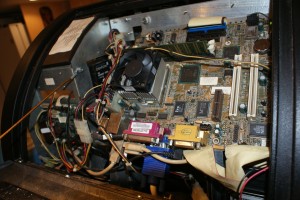During a recent auction, I purchased a Merit Radion Force game system with a dying monitor. As the monitor was unusably dim at maximum brightness settings even under dim light, the cathode gun was likely on it’s way out; and a repair would cost many times more than what I paid for the machine itself. So rather than sink any money into it, I converted the whole machine to LCD using an old Samsung 15″ monitor with an external power brick supply that I hadn’t used in years.




You’ve probably seen a counter top like this, although likely a newer model, in a bar or restaurant. Essentially, they’re designed to sit on a bar-top and play a collection of touch screen games. Each game costs anywhere from $0.25-$2.00 to play, which gives you around 2 minutes of play time. This breed of arcade machine is dying, with the largest manufacturer Merit having announced their shut down 2 months ago; likely thanks to smartphones which run similar games for free.
Anyhow, onto the repair. After giving the whole system a wipe-down and compressor dusting to clean it up, I disassembled the entire plastic shell assembly, leaving just the steel frame and electronics on the base. With the plastic out of the way, I disconnected the power cable to the monitor board, the touch screen’s serial cable, as well as the VGA cable (the whole machine is basically a computer running a custom version of Linux, and is built with all standard parts), peeled away the black duct tape holding the touch screen in place, and removed it from the monitor. The touch screen is made of glass, and is very fragile, so should you attempt this repair, be careful where you place it. After that, I unscrewed the monitor, and pulled it out of the cabinet by unlatching the board from the base. All of the parts were nicely designed to be “snap-in”, so removing it didn’t take long at all. Should you attempt this fix yourself, when removing or working near a CRT monitor, always be sure not to touch any electronics on the board, or attached to the tube (for example, the anode on top). As I’ve said before, the high voltage capacitors on the board are charged and are extremely dangerous if touched. Look up how to discharge monitor capacitors, and follow those instructions before continuing; and DO NOT attempt this fix if you aren’t comfortable working with them.
With the old monitor out of the way (I boxed it up and dropped it off at the local electronics recycling depot), I began preparing the LCD monitor for the switch. I disassembled the case, leaving only the monitor and control panel board, and mounted it where the old monitor was; using picture hanging wire fed through the old screw holes to keep it in place. With the monitor securely in place, I added about an inch of double-sided mounting tape (Dollarama sells it) to all four edges of the monitor, and covered the mounting tape in black duct tape to camouflage the tape with the plastic case. This mounting tape “shield” served to prevent the glass touch screen from scratching against the monitor’s metal edges, and raised it so that it was securely in place along the plastic front casing (which was slightly raised, since the old CRT extended further out of the cabinet.

With that done, I mounted the touch screen, securing it to the monitor with more black duct tape, and reconnected the monitor. Lucky for me, the LCD monitor’s external power brick fit nicely within the cabinet, and used the same plug socket, so that didn’t need to be changed at all. I taped it down to the base, so it wouldn’t slide around while moving. With everything reconnected, I reassembled the plastic shell, and powered it on.







Everything worked fine, and after a quick recalibration, the machine looked and played almost as good as new. The total cost for the repair? About $5 in tape and picture wire, as well as a monitor worth around $15 on Kijiji. Not a bad fix, if you don’t mind the look.
Nice work on the Radion Justin.
I did the same exact procedure on one, and got lucky with an eBay capitave touchscreen that was flat I could use with the 15″ LCD.
I tried later to put together a force from other spare parts I have but did not have another Radion case to house it in. I bought a 3M Microtouch standalone touchscreen monitor (Serial) and found that it didn’t work. I then opened up the touchscreen monitor and replaced the controller with the one from the force unit (the black boxed one bolted right in and the cable to the touchscreen (5-pin, black flat) and the serial port were identical. Still didn’t work. Then I removed the touchscreen and replaced it with one like the one previously purchased from eBay. At that point it worked.
I tell you all this because I have parts to assemble three or so more of these but I can’t figure out which touchscreens work with the force controller (black) and which ones do not. Some say to buy an ELO touchscreens, others say any 3M Microtouch screen will work (which it didn’t for me, even with replacing the controller.)
Do you have any idea how to know which touchscreens themselves are compatible with the black force 3M Microtouch control unit? I would assume that you bought one for this project as the previous screen for the CRT should have been curved and your replacment LCD flat, no?
Any thoughts appreciated. I’ve made it work in the past, but now that I’m buying monitors (which it the most expensive part) I’m trying to do better than hope for dumb luck..!
Thanks
I actually ended up using the original curved touchscreen with the lcd monitor to cut costs. It fit nicely when taped over the screen and extended with mounting tape, so I figured why not.
I did, however, do some research on adding a flat touchscreen before I started. From a forum thread I had found (see link below), it seemed that any 3M MicroTouch monitor would work, provided they were serial and were properly grounded to the chassis.
A Megatouch Force Elite screen would also probably work, as the Elite and Radion use the same software builds.
http://forums.arcade-museum.com/showthread.php?t=102917
Hope this helps.
Thanks!
– Justin
Can you post more detail or pictures about how you secured the LCD in the cabinet using picture hanging wires? I need to do the same exact thing with my Force Radion (replace the LCD), but my replacement LCD doesn’t have the correct hole placement.
Sorry, I didn’t take any others and this machine is long gone. From what I remember, I just wrapped them around the holes in the cabinet and made sure the display wasn’t going anywhere.